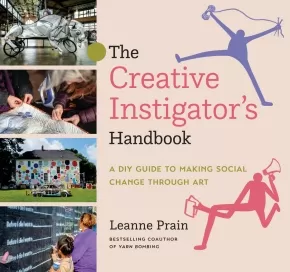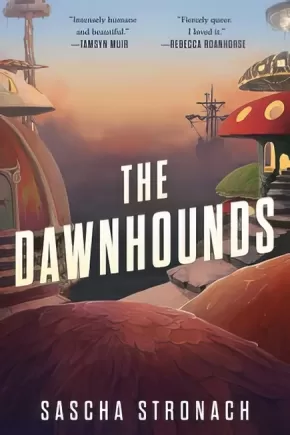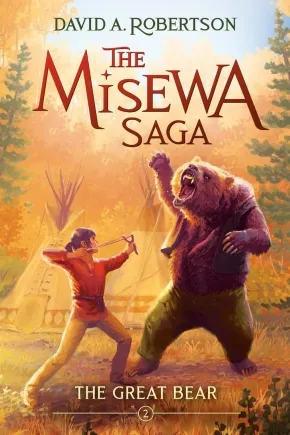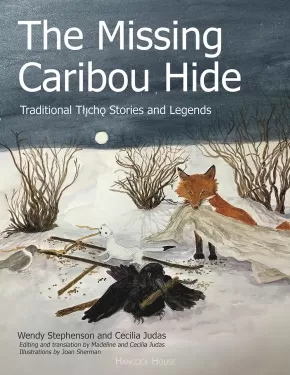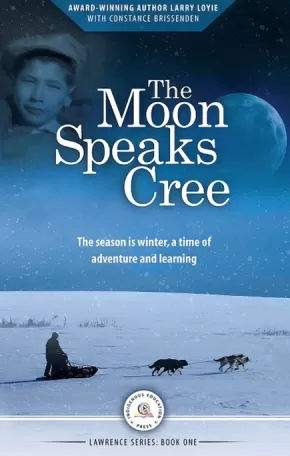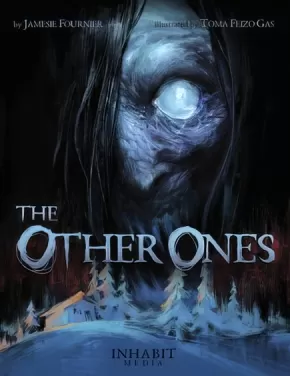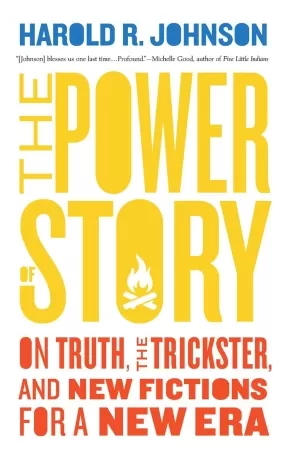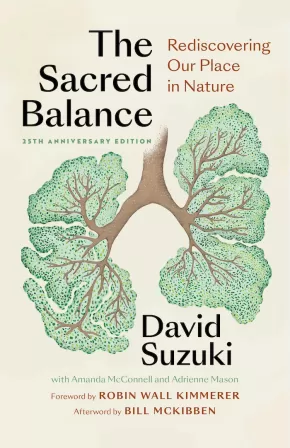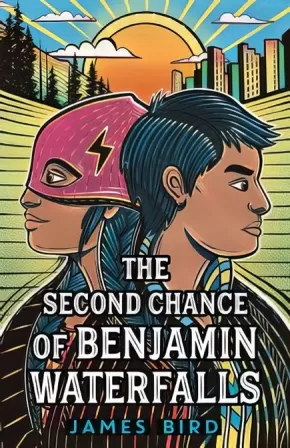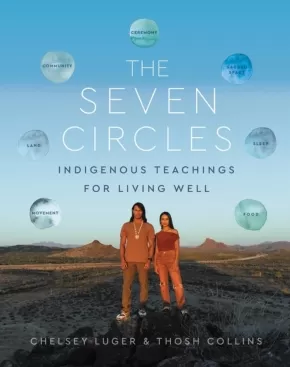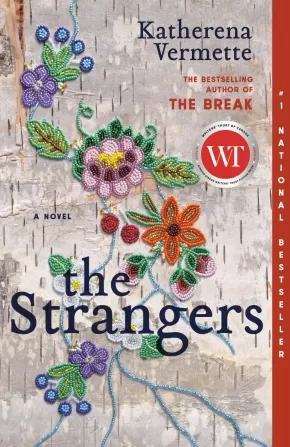
Teen Books
481
-
495
of
1617 Results;
Sort By
Go To
of 108
The Creative Instigator's Handbook: A DIY Guide to Making Social Change through Art
$27.95
Format:
Paperback
ISBN / Barcode: 9781551528755
Synopsis:
Synopsis:
A guide for creatives to making impactful, socially engaged art projects.
Flash mobs come and go, but purposeful creativity can change communities. Are you a creative (aspiring or otherwise) who is curious about how you can apply your skills to activist, socially engaged art projects? Whether you paint, sew, sing, build, weld, or rhyme, The Creative Instigator's Handbook explores how to take that big project you've been dreaming about and actually make it happen.
In response to the challenging times that we live in, The Creative Instigator's Handbook will inspire readers to use their creativity to spur change in the world around them. Guiding readers through the various aspects of a project from ideation to final documentation, the book examines the relationship between creative leadership, community art projects, and social justice, and includes the perspectives of 23 creative instigators who have stretched the boundaries of what "art" should or shouldn't do.
The Creative Instigator's Handbook will appeal to creatives willing to expand their comfort zones by jumping into the fray and doing some outrageous, inspired rabble-rousing of their very own. Full-colour throughout.
Additional Information
272 pages | 8.50" x 8.00" | Paperback
The Dawnhounds
$24.99
Format:
Paperback
Text Content Territories:
Indigenous New Zealander; Maori;
Reading Level: N/A
ISBN / Barcode: 9781982187057
Synopsis:
Synopsis:
Gideon the Ninth meets Black Sun in this queer, Māori-inspired debut fantasy about a police officer who is murdered, brought back to life with a mysterious new power, and tasked with protecting her city from an insidious evil threatening to destroy it.
The port city of Hainak is alive: its buildings, its fashion, even its weapons. But, after a devastating war and a sweeping biotech revolution, all its inhabitants want is peace, no one more so than Yat Jyn-Hok a reformed-thief-turned-cop who patrols the streets at night.
Yat has recently been demoted on the force due to “lifestyle choices” after being caught at a gay club. She’s barely holding it together, haunted by memories of a lover who vanished and voices that float in and out of her head like radio signals. When she stumbles across a dead body on her patrol, two fellow officers gruesomely murder her and dump her into the harbor. Unfortunately for them, she wakes up.
Resurrected by an ancient power, she finds herself with the new ability to manipulate life force. Quickly falling in with the pirate crew who has found her, she must race against time to stop a plague from being unleashed by the evil that has taken root in Hainak.
Reviews
"A wonderful queer noir fever dream."—Tamsyn Muir, internationally bestselling author of Gideon the Ninth
"Fiercely queer. A strange and wondrous re-imagining of noir that takes its cues from biopunk and SE Asian mythos to create something wholly different. There's real imagination at work here—I loved it."—Rebecca Roanhorse, New York Times bestselling author of Trail of Lightning and Black Sun
"The Dawnhounds packs hard-hitting, mind-bending weirdness into a story that’s still touching and human. If you’re looking for gritty queer spec fic that isn’t unrelentingly grim, you’ve found it.”—Casey Lucas, award-winning author of Into the Mire
Educator & Series Information
This book is part of The Endsong series.
Additional Information
352 pages | 6.00" x 9.00" | Paperback
The Geography of Memory: Reclaiming the Cultural, Natural and Spiritual History of the Snayackstx (Sinixt) First People - 2nd Edition
$30.00
Format:
Paperback
Text Content Territories:
Indigenous Canadian; First Nations; Salish; Interior Salish; Sinixt;
ISBN / Barcode: 9781771605212
Synopsis:
Synopsis:
A provocative, historical investigation into the displacement of the Snayackstx (Sinixt) First People of British Columbia’s West Kootenays.
This compact book records a quest for understanding, to find the story behind the Snayackstx (Sinixt) First Nation. Known in the United States as the Arrow Lakes Indians of the Colville Confederated Tribes, the tribe lived along the upper Columbia River and its tributaries for thousands of years. In a story unique to First Nations in Canada, the Canadian federal government declared them “extinct” in 1956, eliminating with the stroke of a pen this tribe’s ability to legally access 80 per cent of their trans-boundary traditional territory.
Part travelogue, part cultural history, the book details the culture, place names, practices, and landscape features of this lost tribe of British Columbia, through a contemporary lens that presents all readers with an opportunity to participate in reconciliation.
Educator Information
Please note that the author of this work is not Indigenous, but the text content is about the Snayackstx (Sinixt) First People. Shelly Boyd, Sinixt/Arrow Lakes Cultural Facilitator provides a Foreword.
In an Introduction to the work, the author notes: "First and foremost, every word of the story of their culture as presented here has been confirmed and accepted as true by the contemporary Sinixt.... Second, because the story also exists within a colonial context, it refers to written materials, published history and textual memories, information that was often recorded by the hand of non-Indigenous People but nonetheless reflects the knowledge of Indigenous generations.... The result is a tapestry, combining threads of history, ethnography, science and personal essays on the natural word.... Sinixit leaders, local historians, and academic experts review[ed] the text prior to publication.... Some non-Indigenous people criticized me for writing about Indigenous People at all, telling me it was not 'my story to tell.' This was, I realize now, a subtle form of silencing. While racism toward Indigenous People still exists across this culture, a groundswell of recognition has begun. In working alongside the Sinixt all these years, I have come to understand that integrating Indigenous perspectives into contemporary culture is not exclusively the responsibility of Indigenous People. As Shelly Boyd so aptly reminds all of us, we, the settlers, need to listen well and with respect. We need to pick up our pens or cameras or drawing pencils, and dig in to help."
It is up to readers to determine if this resource will be useful for their purposes.
Additional Information
280 pages | 6.00" x 8.90" | Paperback
The Gift of the Little People: A Six Seasons of the Asiniskaw Īthiniwak Story
$22.95
Artists:
Format:
Hardcover
Text Content Territories:
Indigenous Canadian; First Nations; Cree (Nehiyawak); Woodland Cree; Rocky Cree;
ISBN / Barcode: 9781553799924
Synopsis:
Synopsis:
Helpless to stop the spread of a deadly sickness, Rocky Cree Elder Kākakiw must travel to the home of the Little People to find a cure before it’s too late.
I don’t recall seeing books when I was a little boy. But the old people, they grew up listening to stories. And so, every night, when the old people were done their evening prayers, they would sit and they would tell us stories too.
At the time of the spring thaw, the Rocky Cree fill their canoes with furs, eager to trade with the new visitors in mistiwāsahak (Hudson Bay). But not all of the new visitors are welcome.
When the canoes return home to the shores of the misinipī river, the Rocky Cree begin to collapse one by one, drenched in sweat and slowly slipping into delirium. Kākakiw struggles to help the sick as more and more people pass into the spirit world. Exhausted physically, emotionally, and spiritually, he seeks guidance through prayer.
Hope finally comes with a visitor in the night: one of the Little People, small beings who are just like us. If Kākakiw can journey to their home, he will be given the medicine his people need. All he has to do is paddle through a cliff of solid bedrock to get there.
To save his people from certain death, Kākakiw must overcome doubt to follow the traditional teachings of the Asiniskaw Īthiniwak and trust in the gift of the Little People.
In this illustrated short story for all ages, celebrated Rocky Cree storyteller William Dumas shares a teaching about hope in the face of adversity. This book is a companion story to The Six Seasons of the Asiniskaw Īthiniwak series.
Reviews
"A tale rich with warmth and wonder that not only documents traditions but carries them on." — David A. Robertson, author The Barren Grounds
Educator & Series Information
Recommended for ages 9 to 11.
Reading Level: Lexile® Framework for Reading: 870L
This book is a companion story to The Six Seasons of the Asiniskaw Īthiniwak series. This series is about the Asiniskaw Īthiniwak (Rocky Cree) of Northern Manitoba. Corresponding to the six seasons of sīkwan (spring), nīpin (summer), takwakin (fall), mikiskow (freeze-up), pipon (winter), and mithoskamin (break-up), the books explore the language, culture, knowledge, territory, and history of the 17th century Rocky Cree people through story and images. The groundbreaking series centres Indigenous ways of knowing and includes insights from a wide range of disciplines—cross-cultural education, history, archaeology, anthropology, linguistics, literature, oral culture and storytelling, experiential and community-based learning, and art.
Contains some Cree language/words, and a glossary of them.
Additional Information
48 pages | 6.00" x 9.00" | Hardcover
The Great Bear (PB)
$12.99
Format:
Paperback
Text Content Territories:
Indigenous Canadian; First Nations; Cree (Nehiyawak); Swampy Cree ;
ISBN / Barcode: 9780735266155
Synopsis:
Synopsis:
In this second book in the Narnia-inspired Indigenous middle-grade fantasy series, Eli and Morgan journey once more to Misewa, travelling back in time.
Back at home after their first adventure in the Barren Grounds, Eli and Morgan each struggle with personal issues: Eli is being bullied at school, and tries to hide it from Morgan, while Morgan has to make an important decision about her birth mother. They turn to the place where they know they can learn the most, and make the journey to Misewa to visit their animal friends. This time they travel back in time and meet a young fisher that might just be their lost friend. But they discover that the village is once again in peril, and they must dig deep within themselves to find the strength to protect their beloved friends. Can they carry this strength back home to face their own challenges?
Awards
- 2022 Silver Birch Award for Fiction
Educator & Series Information
Recommended for ages 10+.
This is the second book in the Misewa Saga.
This book is available in French: Le grand ours.
Additional Information
240 pages | 5.62" x 8.25" | Paperback
The Land Grab
$12.95
Format:
Paperback
Text Content Territories:
Indigenous American; Native American; Sioux; Lakota;
ISBN / Barcode: 9781939053404
Synopsis:
Synopsis:
In 1929, a corrupt land agent used fire and frightening tactics to grab the farm of a Lakota family in Lower Brule, South Dakota.
In 1929 Alfred is eleven years old and has many responsibilities not expected of a young boy. He and his Lakota family are being forced to leave behind their tribal values and traditions and assimilate into mainstream American culture and society. His Lalá (grandfather), has instilled in his grandson many Lakota traditions which Alfred respects, but at times struggles to understand the message they convey. From falling into a den of rattlesnakes, fending off a pack of wolves, to skirmishes with a ruthless land agent and his cronies, this is a page-turner of historical fiction.
Educator & Series Information
Recommended for grades 9 to 12.
This book has a Fry Reading Level of 6.
This is Book 1 in the The Legend of Big Heart Series. The Legend of Big Heart Series takes place during the early twentieth century amid the forced assimilation of Native tribes into mainstream America. The series features the exciting adventures of young Alfred Swallow as he matures into a man and helps his family survive and prosper on the Lower Brule Lakota Reservation in South Dakota.
This is a work of historical fiction. All incidents, events, dialogue, names, and characters except for some well-known historical figures are products of the author’s imagination and are not to be construed as real. Where real-life historical figures appear, the situations, incidents, and dialogues concerning those persons are fictional and are not intended to depict actual events. In all other respects, any likeness to actual persons, living or dead, or actual events is purely coincidental.
This book is part of the PathFinders series of Hi-Lo (high interest, low readability) novels, which offers the following features:
• Indigenous teen protagonists
• Age-appropriate plots
• Contemporary and historical fiction
• Indigenous authors
The PathFinders series is from an American publisher. Therefore, Indigenous terminology in the PathFinders books is not the same as Canadian Indigenous terminology. This prompts a useful teaching moment for educators in discussing appropriate terminology use in Canada.
Additional Information
118 pages | 4.50" x 6.90" | Paperback
The Missing Caribou Hide: Traditional Tlicho Stories and Legends
$12.95
Artists:
Editors:
Format:
Paperback
Text Content Territories:
Indigenous Canadian; First Nations; Dene; Tlicho (Dogrib);
ISBN / Barcode: 9780888397621
Synopsis:
Synopsis:
The Missing Caribou Hide is a story that passes through the years in Tłı̨chǫ history. It tells of times when people lived a simpler life built around the fur trade, hard work and helping one another. It tells of times when relationships with animals and our environment were stronger than they are today.
In this story, a young girl who lives with her grandmother, wishes to own a sled so that she can go sliding like the other children in her community. However, her grandmother needs her to help with chores around the home. The young girl has developed a friendship with Tatsǫ̀ (Raven), Į̀hk'aa (Canada Jay), Nǫ̀mba (Weasel) and Nǫge (Fox). Because of her kindness, the four animal friends decide to help her out.
Included in this book is the use of Tłı̨chǫ language as well as Tłı̨chǫ legends told about these animals from the traditional stories of community elders. It has been edited and translated by the community members themselves.
Reviews
“This book is a reminder of Tlicho and their relationship and connections to their environment and the animals they share their lands with. These stories are important teachings to the cultural history of the Dene People. Not only should the book be in every classroom, but every Canadian should also read these stories to help understand Indigenous peoples and their culture. "The Missing Caribou Hide" can help bridge the gap between not only Tlicho parent and child, but also help connect Indigenous and non-indigenous Canadians alike." — Paul Andrew, Order of the Northwest Territories
Educator Information
Recommended for children.
Included in this book is the use of Tlicho language as well as Tlicho stories told about these animals from the traditonal stories of community elders. It has been edited and translated by the community members themselves. A pronunciation guide is found at the back of the book.
Includes a Christmas story.
Additional Information
48 pages | 8.50" x 11.00" | Paperback
The Moon Speaks Cree
$19.99
Format:
Paperback
Text Content Territories:
Indigenous Canadian; First Nations; Cree (Nehiyawak);
ISBN / Barcode: 9781990297281
Synopsis:
Synopsis:
The Moon Speaks Cree. The season is winter, a time of adventure and learning. Written by Award-Winning Cree author Larry Loyie with Constance Brissenden.
In this book, The Moon Speaks Cree, young Lawrence learns the secrets of winter survival from his parents and grandparents. Based on Larry Loyie’s Traditional Cree childhood, the story teaches lessons on: the effect of change on Indigenous People, respect for culture and history, and universal lessons of Cree culture.
Educator & Series Information
Recommended by publisher for grades 4 to 9.
This book is part of The Lawrence Series.
Additional Information
60 Pages | Paperback
The Other Ones
$19.95
Artists:
Format:
Hardcover
Reading Level: N/A
ISBN / Barcode: 9781772274219
Synopsis:
Synopsis:
“The Net” features a girl and her mother, known only as the mother and the daughter, who arrive at their secluded cabin on a frozen lake to find their fishing net has been attacked, a massive hole ripped through the middle. After the net has been mended and the night’s catch eaten, the daughter sits awake playing with a bit of leftover netting string. When she was a girl, her grandmother taught her to make string figures—just as her mother had taught her—a game played by Inuit for generations, but a game not to be taken lightly . . . as the daughter plays late into the night, and the mother sleeps, other monstrous forces are soon awakened from beneath the frozen lake.
In “Before Dawn” a young boy runs out onto the tundra to play with his new friend by his side, venturing far beyond his mother’s rule that he not stray past the inuksuk on the horizon. The boy’s friend beckons him farther and farther, and the farther they get from home, the more the friend seems to change . . . and shift . . . until he is no longer human at all. Horrified, the boy listens to the creature’s proposition: return home before dawn, or be lost forever to the other side . . .
Complemented by colour illustrations from illustrator Toma Feizo Gas, The Other Ones is a fresh take on modern horror by an exciting new Inuit voice.
Educator Information
Short stories.
Additional Information
50 pages | 6.75" x 8.75" | Hardcover
The Power of Story: On Truth, the Trickster, and New Fictions for a New Era
$22.95
Format:
Paperback
Text Content Territories:
Indigenous Canadian; First Nations; Cree (Nehiyawak); Woodland Cree; Rocky Cree; Montreal Lake Cree;
Grade Levels: 12; University/College;
ISBN / Barcode: 9781771964876
Synopsis:
Synopsis:
Award-winning Indigenous author Harold R. Johnson discusses the promise and potential of storytelling.
Approached by an ecumenical society representing many faiths, from Judeo-Christians to fellow members of First Nations, Harold R. Johnson agreed to host a group who wanted to hear him speak about the power of storytelling. This book is the outcome of that gathering. In The Power of Story, Johnson explains the role of storytelling in every aspect of human life, from personal identity to history and the social contracts that structure our societies, and illustrates how we can direct its potential to re-create and reform not only our own lives, but the life we share. Companionable, clear-eyed, and, above all, optimistic, Johnson’s message is both a dire warning and a direct invitation to each of us to imagine and create, together, the world we want to live in.
Reviews
"Recently in conversation with a friend I remarked that the whole world is a story. Harold Johnson fills that phrase with profound meaning in The Power of Story as he takes ancient figures and modernizes their storied wit and role in creating the worlds we perceive and the boundaries we need. Harold blessed us one last time with a profound conversation on the role of story in every aspect of our lives."—Michelle Good, author of Five Little Indians
“The Power of Story begins where all great stories begin: around a fire. Harold Johnson gives us a seat at the fire to listen and take into ourselves some spellbinding, bracing, and provocative stories told with a view to healing and transforming. As Harold writes ‘It’s starting to get darker now, and a bright fire will help.’ The Power of Story is that bright fire. And it will help. His final book is a balm for our times.”—Shelagh Rogers
Additional Information
192 pages | 5.00" x 8.00" | Paperback
The Sacred Balance: Rediscovering Our Place in Nature - 25th Anniversary Edition
$26.95
Format:
Paperback
Text Content Territories:
Indigenous;
Reading Level: N/A
ISBN / Barcode: 9781771649865
Synopsis:
Synopsis:
“The Sacred Balance has a beautiful spirit.”—E.O. Wilson
With a new foreword from Robin Wall Kimmerer, New York Times-bestselling author of Braiding Sweetgrass—and an afterword from Bill McKibben—this special 25thanniversary edition of a beloved bestseller invites readers to see ourselves as part of nature, not separate.
The world is changing at a relentless pace. How can we slow down and act from a place of respect for all living things? The Sacred Balance shows us how.
In this extensively updated new edition, David Suzuki reflects on the increasingly radical changes in science and nature—from the climate crisis to peak oil and the rise in clean energy—and examines what they mean for humankind. He also reflects on what we have learned by listening to Indigenous leaders, whose knowledge of the natural world is profound, and whose peoples are on the frontlines of protecting land and water around the world.
Drawing on his own experiences and those of others who have put their beliefs into action, The Sacred Balance combines science, philosophy, spirituality, and Indigenous knowledge to offer concrete suggestions for creating an ecologically sustainable future by rediscovering and addressing humanity’s basic needs.
Additional Information
336 pages | 8.50" x 5.50" | Paperback
The Second Chance of Benjamin Waterfalls (3 in stock, In Reprint)
$23.99
Format:
Hardcover
Text Content Territories:
Indigenous American; Native American; Anishinaabeg; Ojibwe (Chippewa);
ISBN / Barcode: 9781250811561
Synopsis:
Synopsis:
A middle-grade novel by James Bird about a boy sent to his Ojibwe family to straighten out his life.
Benjamin Waterfalls comes from a broken home, and the quickest fix he’s found for his life is to fill that emptiness with stuff he steals and then sells. But he’s been caught one too many times, and when he appears before a tough judge, his mother proposes sending him to “boot camp” at the Ojibwe reservation where they used to live.
Soon he is on his way to Grand Portage, Minnesota, to live with his father – the man Benny hasn’t seen in years. Not only is “boot camp” not what he expects, but his rehabilitation seems to be in the hands of the tribal leader’s daughter, who wears a mask. Why? Finding the answer to this and so many other questions prove tougher than any military-style boot camp. Will answers be enough for Benny to turn his life around and embrace his second chance?
Reviews
"Bird's strengths include his multidimensional characters (each of whom has flaws that they struggle to overcome) as well as the vivid descriptions of Grand Portage, Minnesota, home of the Gitchi Onigaming Ojibwe. Of equal importance is the more understated message that Indigenous ways of knowing and approaches to problems can be extremely effective, despite the dominant culture's insistence on discounting them. ... Benny's progress is heartening and sure to encourage readers."— Booklist
Educator Information
Recommended for ages 10 to 14.
Additional Information
288 pages | 5.37" x 8.25" | Hardcover
The Sentence (PB)
$24.00
Format:
Paperback
Text Content Territories:
Indigenous American; Native American; Anishinaabeg; Ojibwe (Chippewa);
ISBN / Barcode: 9780062671134
Synopsis:
Synopsis:
In this unusual and forceful novel, Pulitzer Prize and National Book Award–winning author Louise Erdrich creates a wickedly funny ghost story, a tale of passion, of a complex marriage, and of a woman's relentless errors.
The Sentence asks what we owe to the living, the dead, to the reader and to the book. A small independent bookstore in Minneapolis is haunted from November 2019 to November 2020 by the store's most annoying customer. Flora dies on All Soul's Day, but she simply won't leave the store. Tookie, who has landed a job selling books after years of incarceration that she survived by reading "with murderous attention," must solve the mystery of this haunting while at the same time trying to understand all that occurs in Minneapolis during a year of grief, astonishment, isolation, and furious reckoning.
The Sentence begins on All Soul’s Day 2019 and ends on All Soul’s Day 2020. Its mystery and proliferating ghost stories during this one year propel a narrative as rich, emotional, and profound as anything Louise Erdrich has written.
Additional Information
400 pages | 5.31" x 8.00" | Paperback
The Seven Circles: Indigenous Teachings for Living Well
$36.99
Format:
Hardcover
Text Content Territories:
Indigenous American; Native American; Sioux; Pima (Akimel O'odham); Osage; Haudenosaunee (Iroquois); Seneca; Cayuga; Anishinaabeg; Ojibwe (Chippewa); Turtle Mountain Anishinaabe;
Grade Levels: 12; University/College;
ISBN / Barcode: 9780063119208
Synopsis:
Synopsis:
In this revolutionary self-help guide, two beloved Native American wellness activists offer wisdom for achieving spiritual, physical, and emotional wellbeing rooted in Indigenous ancestral knowledge.
When wellness teachers and husband-wife duo Chelsey Luger and Thosh Collins founded their Indigenous wellness initiative, Well for Culture, they extended an invitation to all to honor their whole self through Native wellness philosophies and practices. In reclaiming this ancient wisdom for health and wellbeing—drawing from traditions spanning multiple tribes—they developed the Seven Circles, a holistic model for modern living rooted in timeless teachings from their ancestors. Luger and Collins have introduced this universally adaptable template for living well to Ivy league universities and corporations like Nike, Adidas, and Google, and now make it available to everyone in this wise guide.
The Seven Circles model comprises interconnected circles that keep all aspects of our lives in balance, functioning in harmony with one another. They are:
- Food
- Movement
- Sleep
- Ceremony
- Sacred Space
- Land
- Community
In The Seven Circles, Luger and Collins share intimate stories from their life journeys growing up in tribal communities, from the Indigenous tradition of staying active and spiritually centered through running and dance, to the universal Indigenous emphasis on a light-filled, minimalist home to create sacred space. Along the way, Luger and Collins invite readers to both adapt these teachings to their lives as well as do so without appropriating and erasing the original context, representing a critical new ethos for the wellness space. Each chapter closes with practical advice on how to engage with the teachings, as well as wisdom for keeping that particular circle in harmony with the others.
With warmth and generosity—and 75 atmospheric photographs by Collins throughout—The Seven Circles teaches us how to connect with nature, with our community, and with ourselves, and to integrate ancient Indigenous philosophies of health and wellbeing into our own lives to find healing and balance.
Reviews
“A life-changing holistic guide to wellness rooted in empowerment, resiliency, and ‘good medicine.’ This book is for any human being searching for wellness solutions in a chaotic world, a true antidote to colonization.” — Vina Brown, Indigenous Scholar, Entrepreneur, Artist, and Professor of Indigenous Studies at Northwest Indian College
“The Seven Circles is a true innovation in Indigenous thought; it brings our shared heritage and traditional teachings to life. Truly inspiring. Readers will find their journey to be a motivating guide for self-transformation.” — Taiaiake Alfred, Mohawk Philosopher
“While the term ‘wellness’ has been co-opted and diluted by (primarily white) social media influencers in recent years, Luger and Collins are recentering the conversation around how to use Indigenous cultural values, foods, and modalities of movement as tools for spiritual, mental, physical, and emotional healing.” — Vanity Fair
“[Two of the] faces in the health and wellness scene that are pushing for inclusivity, justice, and kindness, toppling old conventions to make their own…Luger and Collins rewrite modern narratives regarding Native health while addressing complex histories and ongoing disparities.” — Outside magazine
“Spellbinding. This may be the first book I’ve ever read that made me stop and decide, “I’m making this change now!” Seven Circles opened my eyes to a way of life that is tested by time, guided by nature, and urgently needed today." — Christopher McDougall, author of Born to Run, Natural Born Heroes, and Running with Sherman
“Wisdom abounds in this stimulating offering.” — Publishers Weekly
“Luger and Collins provide a range of sensible, informed, accessible guidance for both small- and large-scale lifestyle changes. An appealing manual for healing the self through Indigenous traditions.” — Kirkus Reviews
Additional Information
256 pages | 7.00" x 9.00" | 75 Colour Photos | Hardcover
The Strangers (PB)
$22.00
Format:
Paperback
Text Content Territories:
Indigenous Canadian; Métis;
ISBN / Barcode: 9780735239630
Synopsis:
Synopsis:
From the bestselling author of The Break comes a staggering intergenerational saga that explores how connected we are, even when we’re no longer together—even when we’re forced apart.
Cedar has nearly forgotten what her family looks like. Phoenix has nearly forgotten what freedom feels like. And Elsie has nearly given up hope. Nearly.
After time spent in foster homes, Cedar goes to live with her estranged father. Although she grapples with the pain of being separated from her mother, Elsie, and sister, Phoenix, she’s hoping for a new chapter in her life, only to find herself once again in a strange house surrounded by strangers. From a youth detention centre, Phoenix gives birth to a baby she’ll never get to raise and tries to forgive herself for all the harm she’s caused (while wondering if she even should). Elsie, struggling with addiction and determined to turn her life around, is buoyed by the idea of being reunited with her daughters and strives to be someone they can depend on, unlike her own distant mother. These are the Strangers, each haunted in her own way. Between flickering moments of warmth and support, the women diverge and reconnect, fighting to survive in a fractured system that pretends to offer success but expects them to fail. Facing the distinct blade of racism from those they trusted most, they urge one another to move through the darkness, all the while wondering if they’ll ever emerge safely on the other side.
A breathtaking companion to her bestselling debut The Break, Vermette’s The Strangers brings readers into the dynamic world of the Stranger family, the strength of their bond, the shared pain in their past, and the light that beckons from the horizon. This is a searing exploration of race, class, inherited trauma, and matrilineal bonds that—despite everything—refuse to be broken.
Reviews
“Katherena Vermette’s The Strangers is a deeply moving story of how colonial institutions continue to bear down on and disrupt the lives of Indigenous women and girls. It is a powerful collective portrait of struggle and resistance, of what it’s like to be in an Indigenous body in twenty-first century Canada. In the end, it adds up to an engrossingly written ode to another kind of care, one against the grain of suffering. A brilliant follow-up!”—Billy-Ray Belcourt, bestselling author of A History of My Brief Body
“The Strangers is a unique and essential triumph of a novel. It is revelatory in its artistry—in its constellating of family against violent separation, in its austere poetics of voice and consciousness. Katherena Vermette has proven once again that she is among the most gifted and relevant writers of our time: someone with everything to teach us about the telling of necessary stories, about grieving the fallen, honouring survival, and revealing the fiercest beauty.” —David Chariandy, award-winning author of Brother and I’ve Been Meaning to Tell You
Additional Information
352 pages | 5.10" x 7.90" | Paperback
Sort By
Go To
of 108

